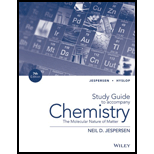
Interpretation:
The
Concept Introduction:
For calculating the age of a rock sample, radiological dating is taken into consideration, which is based on the half-lives of radio nuclides. It uses radiological dating pair of isotopes that undergo ‘parent’ to ‘daughter’ radioactive disintegrations. Carbon dating is one such method for finding the age of an organic sample.
The carbon dating method involves comparative measurements of the ratio of
Want to see the full answer?
Check out a sample textbook solution
Chapter 20 Solutions
Study Guide To Accompany Chemistry: The Molecular Nature Of Matter, 7e
- A chemist studied the reaction mechanism for the reaction 2NO(g)+O2(g)2NO2(g) by reacting N16O with 18O2. If the reaction mechanism is NO+O2NO3(fastequilibrium)NO3+NO2NO2(slow) what distribution of 18O would you expect in the NO2? Assume that N is the central atom in NO3, assume only N16O18O2 forms, and assume stoichiometric amounts of reactants are combined.arrow_forwardFill in the missing parts of the following reactions. a 1327Al+13H1227Mg+? b 612C(11H,?)614Carrow_forwardFluorine-18 is a radioactive isotope that decays by positron emission to form oxygen-18 with a half-life of 109.7 min. (A positron is a particle with the mass of an electron and a single unit of positive charge; the equation is F918O188+e+10 Physicians use 18F to study the brain by injecting a quantity of ?uoro-substituted glucose into the blood of a patient. The glucose accumulates in the regions where the brain is active and needs nourishment. (a) What is the rate constant for [lie decomposition of ?uorine-18? (b) If a sample of glucose containing radioactive fluorine-18 is injected into the blood, what percent of the radioactivity will remain after 5.59 h? (c) How long does it take for 99.99% of the 18F to decay?arrow_forward
- The radioactive isotope 64Cu is used in the form of copper(II) acetate to study Wilsons disease. The isotope has a half-life of 12.70 hours. What fraction of radioactive copper(II) acetate remains after 64 hours?arrow_forwardThe isotope S3890r one of the extremely hazardous species in the residues from nuclear power generation. The strontium in a 0.500-g sample diminishes to 0.393 g in 10.0 y. Calculate the half-life.arrow_forward
 Chemistry: The Molecular ScienceChemistryISBN:9781285199047Author:John W. Moore, Conrad L. StanitskiPublisher:Cengage Learning
Chemistry: The Molecular ScienceChemistryISBN:9781285199047Author:John W. Moore, Conrad L. StanitskiPublisher:Cengage Learning Chemistry by OpenStax (2015-05-04)ChemistryISBN:9781938168390Author:Klaus Theopold, Richard H Langley, Paul Flowers, William R. Robinson, Mark BlaserPublisher:OpenStax
Chemistry by OpenStax (2015-05-04)ChemistryISBN:9781938168390Author:Klaus Theopold, Richard H Langley, Paul Flowers, William R. Robinson, Mark BlaserPublisher:OpenStax Chemistry & Chemical ReactivityChemistryISBN:9781133949640Author:John C. Kotz, Paul M. Treichel, John Townsend, David TreichelPublisher:Cengage Learning
Chemistry & Chemical ReactivityChemistryISBN:9781133949640Author:John C. Kotz, Paul M. Treichel, John Townsend, David TreichelPublisher:Cengage Learning Chemistry & Chemical ReactivityChemistryISBN:9781337399074Author:John C. Kotz, Paul M. Treichel, John Townsend, David TreichelPublisher:Cengage Learning
Chemistry & Chemical ReactivityChemistryISBN:9781337399074Author:John C. Kotz, Paul M. Treichel, John Townsend, David TreichelPublisher:Cengage Learning Chemistry: An Atoms First ApproachChemistryISBN:9781305079243Author:Steven S. Zumdahl, Susan A. ZumdahlPublisher:Cengage Learning
Chemistry: An Atoms First ApproachChemistryISBN:9781305079243Author:Steven S. Zumdahl, Susan A. ZumdahlPublisher:Cengage Learning





